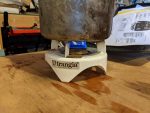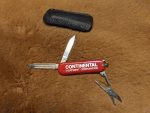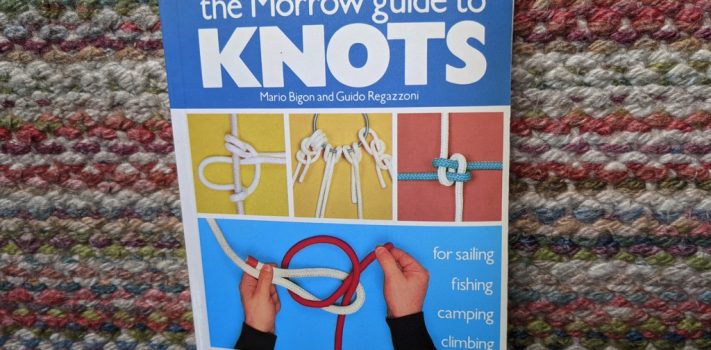Thrift store shopping can yield many useful items. This article is a collection of short reviews about some of my finds. These finds include a pair of boots, a book about knots, a gallon jug of hand sanitizer, and a knife.
A Pair of Boots
When I am harvesting firewood, I like to wear steel-toed boots. My toes just feel happier with a little extra protection when they are in the vicinity of running chainsaws, swinging axes, and rolling logs.
 About a year ago, I was in one of our local thrift stores and ran across a pair of “Skechers Work Relaxed Fit Holdredge-Rebem Men’s Steel Toe Boots.” They were my size. I tried them on and was immediately impressed. They are the most comfortable steel toe boots I have ever worn. If I remember right, they cost less than $10. They are one of the best purchases I have ever made.
About a year ago, I was in one of our local thrift stores and ran across a pair of “Skechers Work Relaxed Fit Holdredge-Rebem Men’s Steel Toe Boots.” They were my size. I tried them on and was immediately impressed. They are the most comfortable steel toe boots I have ever worn. If I remember right, they cost less than $10. They are one of the best purchases I have ever made.
Over the course of the last year I have worn these boots extensively in all kinds of weather. They have kept my feet dry in the rain, warm in the snow, and adequately ventilated in the heat. They are lightweight, sturdy, water-tight, breathable and provide good traction. They are more comfortable than many pairs of hiking boots that I have owned.
I was so pleased with these boots that when I went on a mission project to Montana this past summer, they were the only footwear that I took along. I found them well suited to a full day of wear, whether on an airplane, cutting firewood, siding a cabin, or paddling a canoe. If things went south tomorrow, and I had to abandon my home with just the footwear on my feet, these are the boots I would wear.
The boots have just two drawbacks that I can think of. One drawback is small: the laces tend to come untied, so I need to double knot them. The second drawback is larger: the boots are made in China.
A search of the internet revealed that these boots are currently available from many vendors. The best deal that I could find in my size was from Kohl’s for $74.25 . I was strongly tempted to buy a backup pair, but decided to wait. After all, I might run across another pair at a thrift store.
A Book about Knots
For many years the number of knots that I could tie was somewhat limited. I could manage a square knot and a hangman’s knot and a few other knots which I could not even name. I even knew how to tie my own shoes. But I was never a boy scout nor a sailor, and felt that my knot tying skills could use some improvement. I have often been confronted with a rope and a task and had the feeling that there must be some good knot for accomplishing the task, but I just did not know how to tie it. Sometimes I created my own knots with mixed success. So when my thrift store shopping uncovered a copy of The Morrow Guide to Knots: For Sailing, Fishing, Camping, Climbing, I snatched it up.
The book outlines how to tie seventy of the most useful knots, illustrated with 647 step by step color photographs. According to Booksamillion.com, this book is the world’s best selling tome on the subject of tying knots. That is pretty impressive. The book was originally published in Italian in 1981, and translated into English in 1982. It is printed in Spain.
One thing that I appreciate about the book is that the authors are not snobby about knots. In the introduction, they write, “ . . . it is not necessary to know a great number of knots; four or five–such as the bowline, the sheet bend, the clove hitch, and the figure-eight knot–are sufficient to cope confidently with any situation. The most important thing is to know how to tie them quickly and properly and with the minimum number of movements. The only way to gain the necessary confidence is to practice the knots over and over again until the movements become completely automatic and instinctive.” The real-world experience reflected in those sentences is applicable to much of life. A moderate amount of well-practiced skill is often more useful than a large amount of theoretical knowledge.
The book also includes a good discussion of cordage and the characteristics and practical uses of the various types. Since this book was so popular and had umpteen printings, used copies can often be found on eBay for less than $5 with free shipping!
If you would like to increase your repertoire of knots, then this book would be a good place to start.
70% Alcohol Liquid Hand Sanitizer
Back in October, SurvivalBlog published an article that I wrote that included some information about re-purposing surplus hand sanitizer. For that article, I tested 80% alcohol liquid hand sanitizer as stove fuel, lighter fuel, and as aftershave thinner. I found it effective for all of those tasks.
Recently I was once again in a thrift store, and found a gallon jug of surplus 70% alcohol liquid hand sanitizer for six dollars. I decided to test it as well.
I took the jug out to the barn, emptied the fuel from my Norwegian “Storm Kitchen” alcohol stove, and refilled it with the 70% alcohol sanitizer. I lit the stove with some difficulty using a permanent metal match, and then put a kettle with about a quart of water on the stove.
 The flame of the 70% alcohol sanitizer was a bit anemic compared with what I remembered from the 80% alcohol sanitizer. I wondered if this might be due to the ambient temperature. The temperature during the testing of the 70% alcohol sanitizer was 28 degrees Fahrenheit, whereas the temperature had been much warmer when I tested the 80% alcohol sanitizer. After burning for 18 minutes, the flame from the 70% alcohol sanitizer seemed even more anemic than it had appeared at the start of testing. The flame never developed enough “oomph” to self-pressurize the stove.
The flame of the 70% alcohol sanitizer was a bit anemic compared with what I remembered from the 80% alcohol sanitizer. I wondered if this might be due to the ambient temperature. The temperature during the testing of the 70% alcohol sanitizer was 28 degrees Fahrenheit, whereas the temperature had been much warmer when I tested the 80% alcohol sanitizer. After burning for 18 minutes, the flame from the 70% alcohol sanitizer seemed even more anemic than it had appeared at the start of testing. The flame never developed enough “oomph” to self-pressurize the stove.
I finally decided retest the 80% alcohol sanitizer at the lower ambient temperature. I emptied the stove of the 70% alcohol sanitizer, refilled it with the 80% alcohol sanitizer, and relit it. The flame was immediately more vigorous, the stove self pressurized in less than 15 minutes, and the water boiled soon afterward.
I also tested the 70% alcohol sanitizer as fuel in an IMCO lighter. I used a funnel to fill a Nalgene drop bottle with sanitizer from the gallon jug. I then filled the lighter from the drop bottle. After many flicks of the flint wheel, I finally managed to get the lighter to ignite, but I only managed to do this one time. I guess my IMCO prefers a stiffer drink.
So all in all, I did not find the 70% alcohol liquid hand sanitizer to be effective as a fuel for either a stove or a lighter. By way of contrast, the 80% alcohol liquid hand sanitizer functioned well in both of these applications.
So if you want to re-purpose liquid hand sanitizer as fuel, it will probably work better if it consists of at least 80% alcohol. The 70% alcohol sanitizer will still function well as a disinfectant, for thinning aftershave, and of course for sanitizing hands.
A Knife
 I recently bought a small knife for just 25 cents at a thrift store. It is a Chinese knockoff of a Victorinox Swiss Army Classic SD, decorated as a promo item for “Continental Equipment Corporation.” Pre-9/11, these small knives were handed out at trade shows booths as promotional gifts in large numbers. This copy has a couple of minor variations from the Victorinox SD: the keyring is on the same end as the tweezers and toothpick rather than on the opposite end, and the nail file has an awl rather than a slot-headed screwdriver on the end. Also, the knife came in a small leather case.
I recently bought a small knife for just 25 cents at a thrift store. It is a Chinese knockoff of a Victorinox Swiss Army Classic SD, decorated as a promo item for “Continental Equipment Corporation.” Pre-9/11, these small knives were handed out at trade shows booths as promotional gifts in large numbers. This copy has a couple of minor variations from the Victorinox SD: the keyring is on the same end as the tweezers and toothpick rather than on the opposite end, and the nail file has an awl rather than a slot-headed screwdriver on the end. Also, the knife came in a small leather case.
The blade was not especially sharp upon purchase. A little work with a sharpener brought it into the “barely acceptable” range (it could just barely shave the hair from my left forearm). The tweezers were also a bit on the flimsy side.
I had previously replaced the toothpick in my Victorinox SD with a Tortoise Gear Firefly, which I reviewed in an article published on SurvivalBlog on April 7, 2021. The Firefly is a ferrocerium rod that fits into the toothpick slot of a Swiss Army Knife. When I attempted to test the Firefly in the toothpick slot of the Continental knife, I found the slot to be too narrow. But the Firefly did fit in the tweezer slot, and the tweezers fit into the toothpick slot, so it would be possible to use the Firefly with the unit.
I tried to use the back of the nail file to create sparks with the Firefly, as I usually do with the Victorinox original. These attempts with the Continental knife were not effective. I worked the edge of the file repeatedly with a sharpening stone to try to get better results. These attempts did not succeed. I finally concluded that the steel used in the nail file of the Continental knife is too soft to effectively create sparks with the Firefly.
Next, I tried creating sparks with the edge of the tweezers. They worked well. So it would be possible to effectively use the Firefly to start a fire with the help of the Continental knife.
I decided to keep the Continental knife as a backup. After all, two is one, and one is none. I recently lost my Victorinox SD for a time in a chair at my Mom’s house while I was visiting her. My wife found it a week later. So I am glad to have the Continental knife as a backup. Although I cannot expect Swiss quality from a Chinese knife, even a Chinese knife is usually better than no knife at all.
Disclaimer
I did not receive any financial or other inducements to mention any vendor, product, or service in this article.










